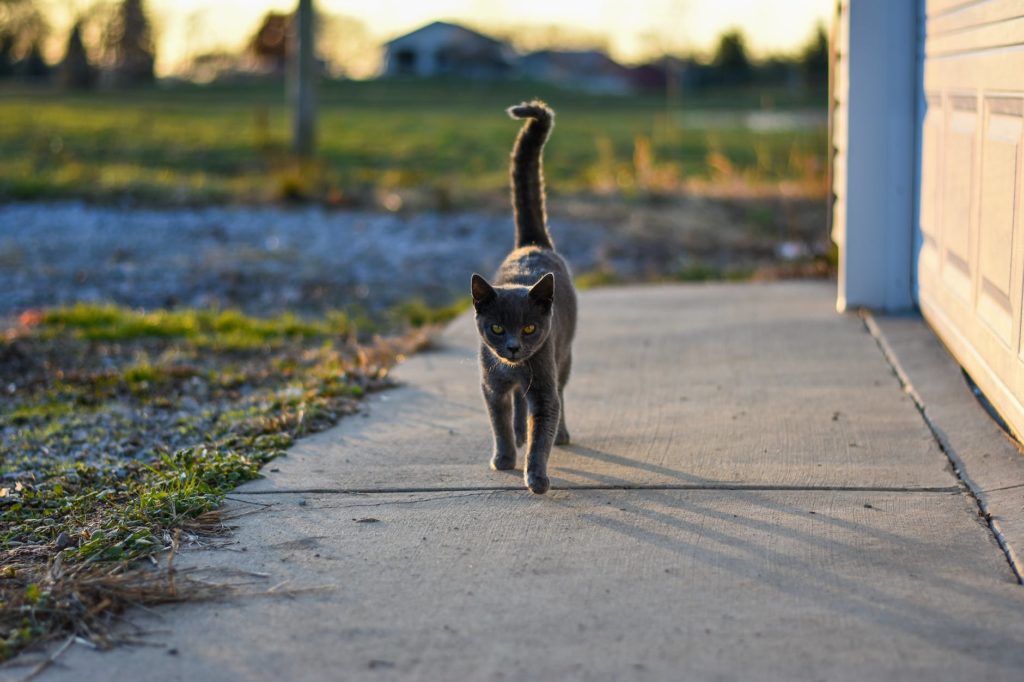Cat Chases Its Own Tail
Table of Contents
1. The Instinctual Hunter
Throughout evolution, domestic cats have retained many of the predatory traits of their wild ancestors. One compelling reason your cat chases its own tail lies in its instinctual hunting behavior. In the wild, cats frequently engage in play to develop skills needed for stalking and capturing prey. This playful behavior often manifests in their daily routines, even when the only target around is their own tail.
Furthermore, this predatory instinct is particularly evident in kittens. Young cats have a natural zest for exploration and learning, making them highly susceptible to tail-chasing antics. Cat Chases Its Own Tail. The act of pouncing on their tail mimics the excitement of chasing a small animal, allowing them to hone their instincts while having fun.
2. Excess Energy Needs Outlet
Cats are naturally energetic creatures. If indoor cats do not expend sufficient energy through play or exploration, they may invent their own entertainment—like tail chasing. Cat Chases Its Own Tail. This behavior provides a quick release to pent-up energy, entertaining your feline friend and giving it an outlet for its restlessness.
Moreover, young cats and kittens tend to have higher energy levels. If they lack stimulation from toys or human interaction, it’s common for them to find diversion in their tail. Cat Chases Its Own Tail. It is both a physical exercise and a mental challenge, providing an engaging spectacle for any onlooker, as they whirl and leap in pursuit of their elusive appendage.
3. The Allure of Movement
Cats are visual hunters, and they are instinctively drawn to objects that move. As your cat moves its body, the tail dances enticingly in its field of vision. This natural allure can trigger the chase instinct in your pet, prompting it to engage in a playful pursuit. The fast and erratic movements of the tail can be irresistible to a curious cat.
Additionally, the chase becomes even more captivating when the cat begins to use its paws for agility and quick footwork. Such movement not only catches the cat’s attention but engages its mental faculties as it calculates its next move. Cat Chases Its Own Tail. Thus, your cat’s tail can transform from an ordinary body part into a fascinating toy.
4. Stress or Anxiety Relief
Chasing its own tail can also be a coping mechanism for your cat when it feels stressed or anxious. In situations where there’s noise from outside, changes in the home environment, or if new pets or people arrive, your cat may feel threatened. In response, tail chasing becomes a form of self-soothing that helps alleviate stress.
Additionally, repetitive behaviors often occur in animals experiencing anxiety. Cat Chases Its Own Tail. Tail chasing may serve as a behavioral escape route that allows your cat to distract itself from whatever it perceives as a threat. This tail-centric distraction may provide comfort in times of tension, helping your feline friend regain its composure.
5. Boredom: A Feline Foe
Boredom is a significant issue for indoor cats, leading to tail chasing as an amusing pastime. Your cat thrives on stimulation and sensory experiences. Cat Chases Its Own Tail. Without engaging toys or interactive play, it may turn to its tail for entertainment as a way to fill the void of boredom.
To combat this behavior, it’s essential to provide your cat with various toys, vertical spaces for climbing, or interactive play sessions with you. Cat Chases Its Own Tail. Incorporating regular activities into your cat’s routine can reduce the likelihood of tail chasing, fostering a happier and healthier lifestyle for your furry friend.
6. Attention-Seeking Behavior
Cats are surprisingly adept at communicating their needs, often using their behaviors to attract human attention. When chasing its tail, your cat may deliberately engage in a display designed to elicit a reaction from you. Cat Chases Its Own Tail. If your cat realizes that chasing its tail garners laughter, affection, or even exasperation, it may continue doing so to keep you engaged.
Moreover, reinforcing this behavior can create a cycle that your cat enjoys. Every time you notice its antics and respond, your cat learns that this particular show brings positive attention. Cat Chases Its Own Tail. In such cases, tail chasing becomes not just play, but also a way for your cat to connect with you and foster bonding.
7. The Playful Nature of Kittens
Kittens, in particular, are notorious for chasing their own tails. Infused with boundless energy and an innate curiosity, they explore their surroundings through play. Cat Chases Its Own Tail. Tail chasing is particularly captivating for younger cats since they often don’t yet grasp the physical limits and skill sets involved in feline antics.
Furthermore, tail chasing provides education. As kittens learn to assess distance, movement, and spatial awareness, this behavior serves as a practical exercise in these burgeoning skills. Cat Chases Its Own Tail. As they practice coordination, they also develop vital social skills that will assist them as they grow and interact with both humans and other animals.
8. A Unique Form of Play
Tail chasing can sometimes evolve into a unique form of solo play. Cat Chases Its Own Tail. Unlike playing with toys or engaging in interactive play with humans, this behavior allows your cat to engage in self-directed fun. In many ways, tail chasing is akin to a personal game that your cat invents, and it may enjoy the thrill of outsmarting its “prey.”
This individualistic play serves a dual purpose. Not only does it encourage physical activity, but it also keeps your feline mentally stimulated. Cat Chases Its Own Tail. The mental engagement from chasing and catching a moving target can be similar to more complex puzzle-based games, ensuring that your cat remains stimulated and content.
9. A Possible Sign of Compulsive Behavior
While tail chasing predominantly stems from normal behavioral instincts and playful antics, in rare cases, it can signal compulsive behavior. If your cat chases its tail excessively—beyond fun or play—it may indicate underlying stress, anxiety, or even a medical issue. Cat Chases Its Own Tail. If you observe your cat spending an unusual amount of time in this behavior, paying attention and consulting a veterinarian is prudent.
Additionally, compulsive behaviors in cats can stem from various factors, including lack of environmental enrichment or emotional distress. Cat Chases Its Own Tail. By monitoring your cat’s habits and lifestyle, you can help identify whether it’s a benign diversion or a signal of deeper emotional needs that must be addressed.
10. Genetics and Individual Personality Traits
Each cat possesses a unique personality shaped by genetics and environment. Some breeds, such as Abyssinians and Siamese, are known for their playful and energetic behavior, making them more prone to chasing their tails. Cat Chases Its Own Tail. Others may simply be more curious or whimsical, leading to frequent tail-chasing episodes.
Moreover, just like humans, each cat has its own quirks and idiosyncrasies. Some cats chase their tails more often than others based on individual preferences. Cat Chases Its Own Tail. Recognizing your cat’s unique traits enables a better understanding of its behavior and ensures you provide the best environment tailored to its personality.
Your cat’s tail-chasing escapades can be attributed to a fascinating mix of instinct, curiosity, energy, and the need for stimulation. By appreciating these myriad reasons, you can enhance your cat’s environment and strengthen your bond as you engage in both play and understanding. Cat Chases Its Own Tail. Tail chasing is not just a quirky cat behavior; it is a glimpse into the complex world of feline instincts and personality traits. So, the next time you see your cat chasing its own tail, you may just find it more intriguing—and perhaps even more endearing—than you once thought!

Why Does My Cat Chase Its Own Tail? Understanding Feline Behavior
Cats are known for their playful and curious nature, and one behavior that often captures their attention is chasing their own tail. Cat Chases Its Own Tail. While it may seem amusing to watch, many cat owners wonder why their feline friend engages in this quirky behavior. In this article, we’ll explore some of the reasons why cats chase their own tail.
One primary reason for this behavior is instinctual; cats are natural hunters, and the movement of their tail can trigger their predatory instincts. Additionally, cats may chase their tails out of boredom or excess energy, especially if they lack stimulating toys or activities. Cat Chases Its Own Tail. This playful chasing can serve as an outlet for pent-up energy, helping them remain physically active.
Furthermore, some cats may develop this behavior due to anxiety or stress, seeking a way to cope with their feelings. Cat Chases Its Own Tail. Understanding these motivations allows cat owners to provide a supportive environment, ensuring their furry friends stay happy and healthy.
Live Pee Free! Odor Eliminator 100% Eliminates Pet Odor on Contact. 20% Off. No Enzymes, No Fragrance, No Detergent, No Bleach – Safe for Kids and Pets.Instinctive Behavior
One reason why cats may chase their own tail is due to instinctive behavior. In the wild, cats rely heavily on their agility and finely tuned hunting skills to catch prey, which includes small rodents and birds. The act of chasing their own tail can serve as a playful reenactment of these predatory instincts. Cat Chases Its Own Tail. For domesticated cats, who may not have the same opportunities for hunting as their wild counterparts, tail-chasing provides a creative outlet to exercise their natural instincts and hone their skills.
This behavior can also be seen as a way to relieve boredom and excess energy. Cats are naturally curious and playful creatures; engaging in tail-chasing allows them to simulate a hunting scenario without the pressure of capturing real prey. Cat Chases Its Own Tail. Additionally, tail-chasing can stimulate mental engagement, as cats may become engrossed in the movement of their own tail, which they often perceive as a potential target.
Ultimately, while this behavior may seem amusing to us, it is deeply rooted in their instinctual need to chase and catch. Understanding this aspect of feline behavior not only illuminates their wild nature but also helps cat owners provide appropriate means to keep their pets mentally and physically stimulated.

Boredom or Lack of Stimulation
Cats are highly intelligent animals and require mental stimulation to keep them happy and healthy. Their natural instincts drive them to explore, hunt, and play, which are essential activities for their mental well-being. If a cat is bored or doesn’t have enough stimulation in their environment, it may resort to chasing its own tail as a way to entertain itself. Cat Chases Its Own Tail. This behavior can be seen as both an expression of energy and a coping mechanism for boredom.
Additionally, a stimulating environment is crucial for a cat’s physical and emotional health. Simple toys, interactive play sessions, and climbing structures can significantly enhance a cat’s living space. Engaging with a variety of toys, such as feather wands or laser pointers, can help satisfy their hunting instincts and redirect their energy in a positive direction. Cat Chases Its Own Tail. Without these activities, a cat may not only chase its tail but might also develop other behavioral issues, such as aggression or anxiety.
To prevent boredom, it’s essential to rotate toys regularly and provide new challenges. Cat Chases Its Own Tail. Consider incorporating puzzle feeders that require the cat to think critically to obtain treats, which can further keep their minds sharp and satisfied. A well-stimulated cat is a happy cat!
Stress or Anxiety
Cats may also chase their own tail as a way of coping with stress or anxiety. This behavior can serve as a self-soothing mechanism that helps cats feel more relaxed and secure in their environment. Cat Chases Its Own Tail. Just like humans might engage in repetitive behaviors when feeling anxious, such as tapping their fingers or pacing, cats often resort to similar actions to manage their emotional state. Chasing their tail can provide them with a temporary distraction from whatever is causing them distress.
It’s essential for cat owners to observe their pets closely and identify any signs of stress or anxiety, which can manifest in various ways, such as excessive grooming, hiding, or changes in eating habits. Cat Chases Its Own Tail. Common triggers for feline anxiety include changes in their environment, the introduction of new pets or family members, loud noises, or even a lack of stimulation.
If you notice that your cat is frequently chasing its tail, it may be indicative of an underlying issue that needs to be addressed. Cat Chases Its Own Tail. Creating a calm and enriched home environment with plenty of playtime, comfortable resting places, and engaging toys can help alleviate stress and promote overall well-being. Addressing these underlying causes is crucial for ensuring the happiness and health of your feline companion.
Medical Issues Related to Tail Chasing in Cats
In rare cases, cats may chase their own tails due to underlying medical issues that can affect their behavior. Conditions like fleas, parasites, or skin allergies can lead to irritation or discomfort, prompting a cat to chase or bite at its tail as a response. When a cat is plagued by fleas, they may experience intense itching and irritation, causing them to become overly focused on their tail as a source of discomfort.
Similarly, internal parasites can cause general unease and manifest in various behavioral changes. Skin allergies, whether due to environmental factors or specific allergens in their food, can also lead to similar outcomes, where the cat resorts to tail chasing as a way to cope with the itchiness or irritation.
If you notice your cat excessively chasing its tail, it may be a signal that something is not quite right health-wise. This behavior should not be dismissed as mere playfulness or instinctual fun. Instead, it warrants closer observation and potentially a visit to the veterinarian to rule out any underlying medical issues.
The veterinarian may conduct a thorough examination and possibly suggest tests to ascertain the root cause of the behavior. It’s crucial to address any medical concerns early, as conditions causing discomfort can escalate if left untreated.
On the other hand, there are numerous non-medical reasons why cats might chase their tails. One prominent factor is instinctive behavior. Cats possess deep-seated hunting instincts, and chasing their tails can mimic the actions of a predator stalking its prey.
This natural inclination offers them a form of entertainment, especially when they are feeling playful or energetic. Additionally, young kittens are especially prone to this behavior as they learn about their bodies and their environment. They often engage in tail chasing as a form of exploration or play.
Another reason for tail chasing could be boredom. Cats require stimulation through play, interaction, and mental challenges to remain happy and healthy. A lack of proper engagement can lead to behaviors that might seem odd or playful but actually stem from a need for enrichment.
Chasing their tails can provide a temporary solution to their boredom, turning into a mental and physical outlet to channel their energy. To combat boredom, enriching the cat’s environment with interactive toys, climbing structures, and engaging playtime with owners is essential to keep them occupied and satisfied.
Stress or anxiety can also trigger this behavior in cats. Changes in the household, such as moving to a new home, the arrival of a new pet, or changes in routine, can lead to feelings of insecurity in cats. When they feel anxious, they might engage in self-soothing behaviors, including tail chasing. Recognizing signs of anxiety in your cat, such as excessive grooming or hiding, will be crucial in addressing these concerns. Providing a stable, safe environment and reducing changes in their routine can help in alleviating stress.

In conclusion, cats may chase their own tails for a myriad of reasons, including instinctive behavior, boredom, stress or anxiety, and medical issues. While tail chasing may appear harmless, it’s important to ensure that your cat has sufficient mental and physical stimulation to maintain a healthy, happy lifestyle. If tail chasing becomes excessive or is accompanied by other concerning behaviors, consulting with a veterinarian is vital.
Your vet can guide you in determining whether the behavior is purely playful or if it signals deeper concerns that require attention. By paying close attention to your feline friend’s habits and needs, you can ensure they lead a joyful life, free from discomfort or distress.



